Australian Rain Forests
We haven’t done much exploring outside of New Zealand lately so we decided to take advantage of some cheap flights and flew to Cairns in northeast Australia to explore the Daintree Rainforest and Atherton Tablelands, all within easy reach of Cairns.
This is the area we explored.

I didn’t know what to expect. My earliest images of Australia were based on The Road Warrior and Crocodile Dundee and I imagined lots of desert and open spaces. Since then I’ve been to the big east coast cities like Sydney, Melbourne and Brisbane and was always surprised how green everything is.
But nothing prepared me for the rainforests we visited. They call the area the “Wet Tropics.” They are well named. It was the “dry season” but it rained every day we were there. And yes, there are poisonous snakes and spiders. And leeches.
But don’t get me wrong. It was beautiful and amazing and fortunately we didn’t get a single mosquito bite.
We picked up the car in Cairns and headed north. Cairns is on the coast of the Coral Sea and is the gateway to the Great Barrier Reef. The road up north mostly follows the coast.

After a couple of hours you come to the Daintree River.

There is no bridge, only a ferry which will take 27 cars at once.

As soon as you get off the ferry you know you are in the rainforest.

Our first couple of days we stayed in a place called Cow Bay. It is right on the water but you don’t know it because the rainforest goes right down to the shore. The place we stayed was called Crocodylus, which wasn’t very reassuring. That is the Latin name for the saltwater crocodile which lives in the estuaries. As recently as May someone was eaten by a crocodile at Cow Bay and it’s a good idea not to ignore the warnings.
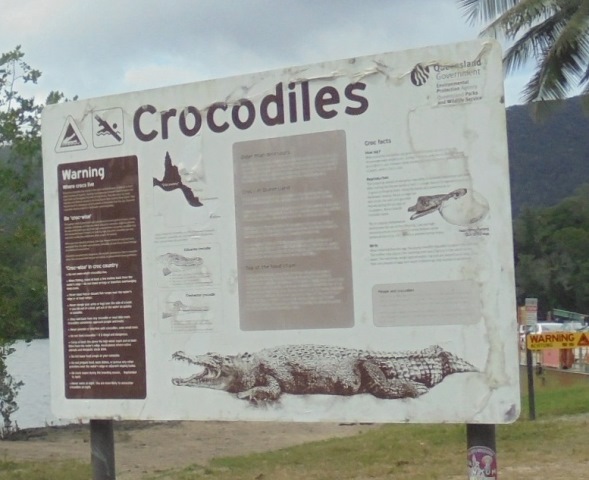

We did see a crocodile on a boat ride and from the way the skipper behaved I could tell he had a lot of respect for it. This one is 4 metres or about 12 feet long.

The Daintree area is sparsely populated and we really enjoyed meeting some of the locals, who were all interesting characters. The farthest north we got was Cape Tribulation. It got its name because Captain Cook ran into trouble there. Captain Cook named a lot of places in Australia and NZ and he was very imaginative. In NZ we have Poverty Bay, Doubtless Bay and Cape Foulwind.
The local cafe at Cape Tribulation, which serves crocodile, kangaroo and emu burgers, is a nice laid back place and had some interesting signs.


And here is the helpful weather report provided by the front desk at Crocolylus.

Speaking of which, this was our accommodation at Crocodylus. We wanted to be in the rainforest and got our wish.
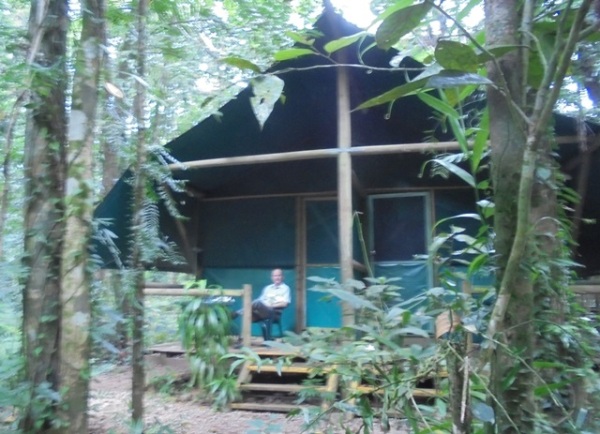

We also stayed at places on the Daintree River and in the Atherton Tablelands that were very close to nature.
The main attraction at all these places was the rainforests and the animals.
First of all, though, let me clarify a few things. Rainforests are essentially forests that exist in areas of high rainfall. Because of the conditions they usually have a variety of plant and animal life. A lot of the rainforest in the areas we visited is recovering after being cleared but there are areas of untouched forest and the entire area is a World Heritage Site.
Rainforests are not for the faint hearted. They are never quiet, but at dawn when the birds start their day they are positively noisy! And the variety of birdcalls is amazing. There are also, at least in these rainforests, a lot of things that you don’t want to encounter like poisonous snakes, spider and centipedes. One of the biggest dangers, however, is wild pigs.
We did a lot of exploring – walking on all sorts of paths from the luxurious —

To the scary–


We saw lots of interesting plants.

This is called a fan palm.

Where the rainforest meets the ocean there are mangrove swamps in the estuaries and the mangrove trees and roots sometimes look like something from outer space.



One of the most amazing trees we found is the strangler fig. It originates from the seed of a normal fig tree but when a certain wasp lays its eggs in the seed and carries it to the top of an existing tree it can germinate and send airborne roots down to the ground. The roots harden around the host tree and eventually kill it. When the host tree dies, the strangler fig appears hollow.

When the seed lands at the top of a huge old tree and the fig has been growing for a long time, the results can be amazing. This one is called the Curtain Fig. At some point in the process the host tree fell against another tree and the strangler fig roots have created a “curtain.”



This one is called the Cathedral Fig. The canopy is 1,250 square metres and it is estimated to be over 500 years old.


Care for another fun fact?
We didn’t know this, but in this part of Australia there are no native bees to help plants pollinate. And because birds, who are also pollinators, don’t like flying from flower to flower in dense foliage where they can’t spread their wings, Australian trees have developed flowers on their trunks instead of in the branches. This way insects and other creatures walking on the trunk will pollinate the flowers. The characteristic is called “cauliflory” and you can see the flowers on the trunk of this tree.

Here is a rainforest flower related to the gardenia.

And here is something called a basket fern which grows high up in trees and is a ready made home for birds, snakes, frogs, insects and even other plants.

And some pretty glow in the dark fungi.

These are flowers of the jade vine.

And here are two of the few unlogged Australian Kauri which are cousins of New Zealand’s largest tree.

In addition to the new and interesting plants, we also enjoyed the unusual birds and animals. The big draw in the area is the cassowary which looks like a cross between an ostrich and a dinosaur. This is how big the females can get and although we didn’t spot any real ones the advice is to give them a wide berth because they have a bad temper and sharp beaks and claws.

We did however see some paddy melon wallabies and kangaroos.

This is a platypus in search of food.

We went for an interesting night walk in the forest and saw a lot more than we could photograph. There were centipedes and spiders and cane toads which are poisonous. It was especially worrisome when a huge centipede jumped across the path in front of us and our guide said, “I didn’t know they could do that.”
If things didn’t move too fast we were able to get pictures. Can you spot the interesting cricket with the long antennae trying to camouflage itself on a stick?

Here is a Boyd’s Forest Dragon.
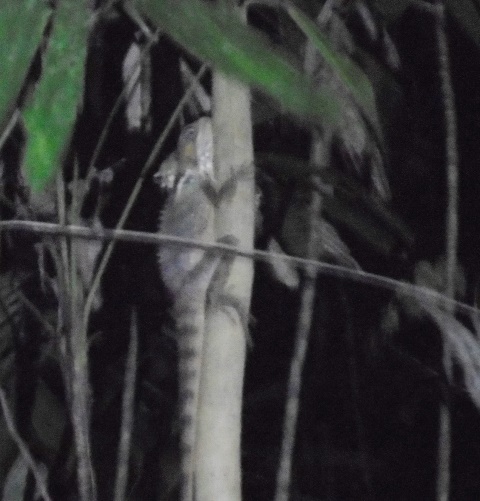
The rain forests here are also renowned for the variety of birdlife. We heard and saw lots birds and almost all of them were new to us like the Victoria’s Riflebird and Golden Bowerbird below.

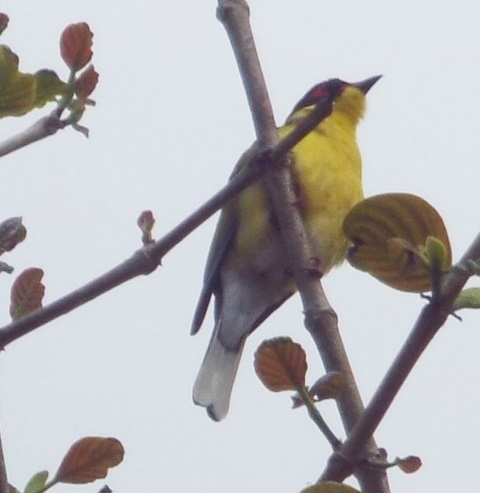
While on a dawn birdwatching tour on the Daintree River we saw some more very interesting and colourful birds

. . . and giant bats known as flying foxes — their wingspan is a metre wide.

At the Hasties Swamp National Park in the Tablelands, we couldn’t believe the number and variety of ducks as well as swans and pelicans.


The last place we stayed was by Lake Eacham in the Atherton Tablelands, and our lodging was also set in the midst of a rainforest. The owners here encourage the guests to interact with the animals by leaving fruit for the birds on the cottage porch. Each morning we put orange and tomato pieces out on the railing and got lots of visitors. The big bird is the bush turkey and the little one is Lewins Honey Eater.
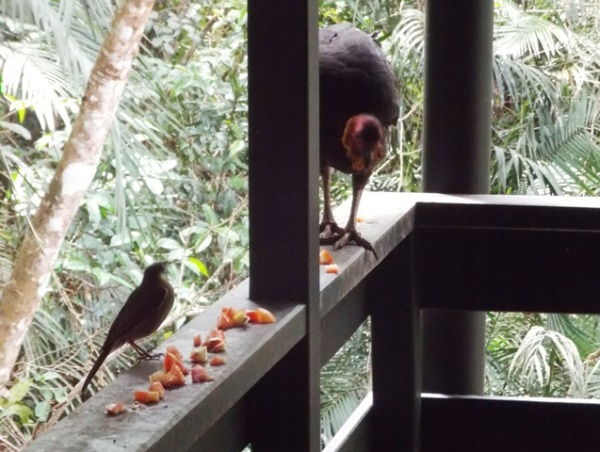
This place also had a lighted viewing platform where at night they put honey on a couple of trees to attract animals. The animals are too busy eating to pay attention to the people taking their pictures.
This is a striped tail possum:

Here’s a sugar glider:

And a long nosed bandicoot:

The Tablelands area is quite volcanic and has many beautiful waterfalls. We spent a morning exploring the Millaa Millaa Falls circuit which is circular road that takes you to several waterfalls in the area.
This is Millaa Millaa Falls, looking just like a waterfall should!

This is Zillie Falls.

And here is Ellinjaa Falls.

There were never ending interesting things along the way. I wasn’t sure to laugh or cry about this sign at the base of a tall tower that you could climb up for a panoramic view of the rainforest canopy at the Daintree Discovery Centre.

Be glad that I’m sparing you a selfie from the top of the tower!
We’d heard about the problems with jellyfish on Australian beaches and it’s no joke:

They actually have a bottle of vinegar in that little tube which you are supposed to spill on stings.
It wasn’t all wilderness. We visited a number of little towns. One of our favourites was Yungaburra. It has a population of 1,100 and several heritage buildings, including this one that looks iconically Australian to me.

There were a number of whimsical shops. At the Mad Hatter Café everything is Alice in Wonderland themed.

And they have an interesting community arts centre.


We also did a bit of non-tourist stuff. The School for Field Studies Centre for Rainforest Studies is located in the Atherton Tablelands and each year for the past three years, Dr. Amanda Freeman, centre director, and several students and faculty have visited New Zealand and stayed at CUE Haven and helped us with our restoration planting.
We didn’t exactly return the favour because we didn’t do any work, but we spent a nice day meeting up with old friends and seeing their facilities.
We met them at a community nursery operated by TREAT (Trees for the Evelyn and Atherton Tablelands). The SFS team was helping out in the morning with a community working bee. Volunteers from the area grow and nurture the trees until they are ready to be planted and then participate in community planting days to restore and extend the rainforests. It was very interesting talking to the volunteers and learning of their efforts to restore their rainforest.


We then went over to the SFS centre for a tour and to meet the rest of the staff and students. Amanda showed us some of the research and experiments they are working on to see how to improve the effectiveness of rainforest restoration.

The next day we headed back to Auckland. It was a short but very interesting and enjoyable trip. We learned a lot and met some great people and we look forward to exploring more of Australia.
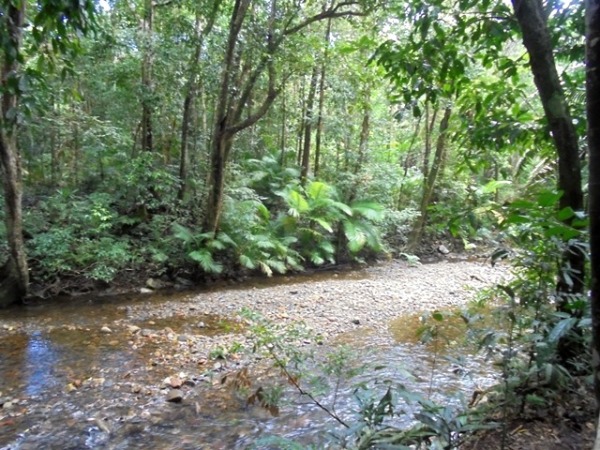

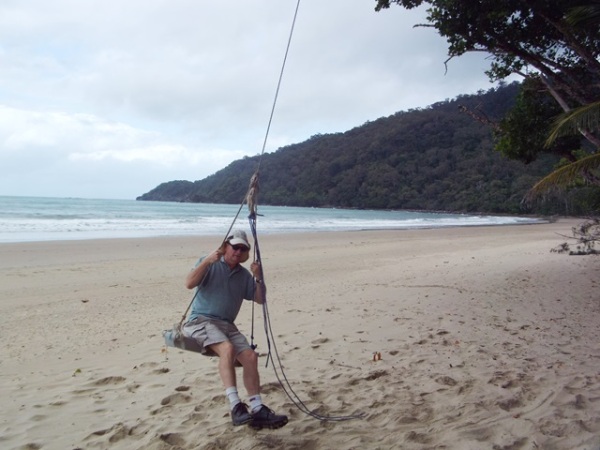




Very Interesting.
Love the picture of the Cafe’s operating hours!
I could never understand how Austrians can ever relax and enjoy life, being perpetually surrounded by venomous snakes and gators and spiders and other deadly creepy crawlies (in addition to cars and malfunctioning toasters and other grave threats to life and limb that all of us face on a daily basis).
Australians
Good question. I’ve had people who live in the cities tell stories about being chased by aggressive spiders while they were cutting the grass. And don’t forget the regular stories about people finding snakes in their toilets!
Yeah, or you’re chilling on your porch and suddenly this happens: